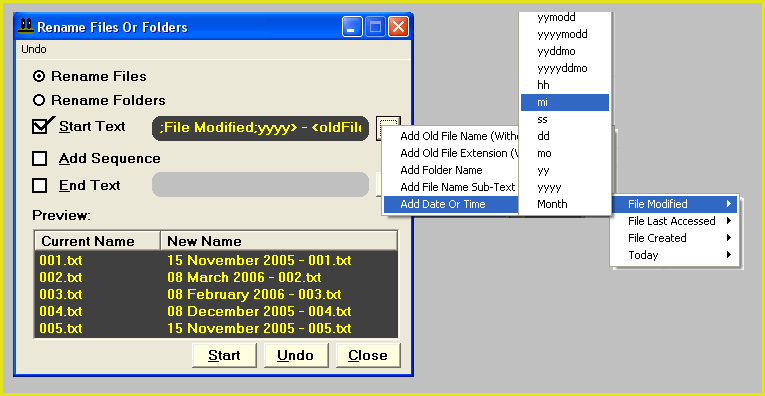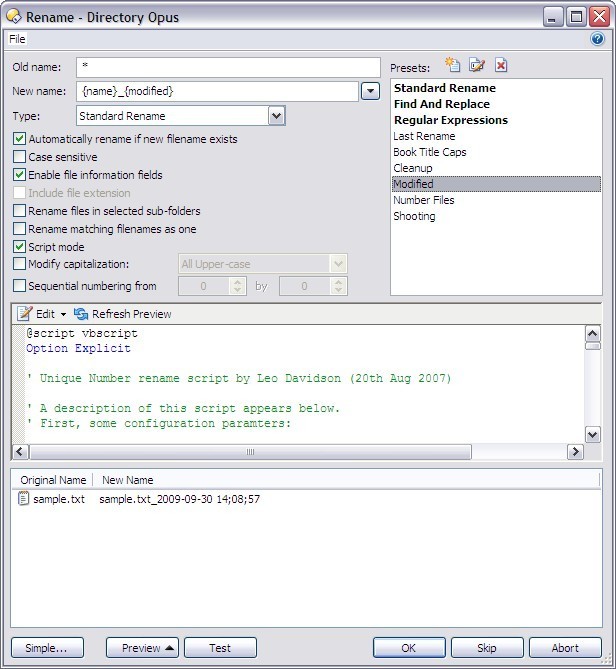
- #EXIFTOOL RENAME FILES BY DATE FULL#
- #EXIFTOOL RENAME FILES BY DATE SOFTWARE#
- #EXIFTOOL RENAME FILES BY DATE PC#
# No liabilty of any kind is accepted or provided.
#EXIFTOOL RENAME FILES BY DATE SOFTWARE#
# This software is provided "as is" with no implied or explicit warranties or guarantees. # Be sure to include any punctuation as shown above or the command will not work.
#EXIFTOOL RENAME FILES BY DATE FULL#
script_path/ConvertVideoFilename.ps1 'Video_Files_Path' options # where script_path is the full path to the location of this script, and # Video_Files_Path is the full path to the location where the video files are located # options are: q = quietmode, no messages, and # e = show error messages if in quiet mode # If no options are specified then each file found is listed. D:\Scripts # 2) Make sure the exiftool has been downloaded and saved and the # toolpath below set accordingly # 3) Open a CMD window # 4) Change to the scripts folder # 5) Enter command: # powershell. # To use this script: # 1) Save the script to a folder on the computer, e.g. Kiess # Date: # Powershell script to rename sequentially numbered video files # to the standard date/time format YYYYMMDDHHMMSS. # ConvertVideoFilename.ps1 # Author: Walter H. The script can be executed from the Windows Cmd line using this syntax:

Someplace where you keep all your utility programs, etc. The script should be saved to a folder on the PC, e.g., D:\Scripts or C:\Utils. I needed a way to do this myself without the app and I had 1600 files to rename and thus I developed this Powershell script to do the work for me.
#EXIFTOOL RENAME FILES BY DATE PC#
Using the camera's application software, the files would be copied over to the PC and renamed based on the file's original creation date and time, e.g., 20190223113432.m2ts, i.e., YYYYMMDDHHMMSS.ext format. The problem with this method is that the files are named in a sequential fashion starting at 00000.mts and incrementing by one for each subsequent video file. The only way to get the files off the hard drive was to manually copy the files across to my computer using Windows File Explorer. This meant I could not download and then clear the hard drive ready for the next shoot. The camera's application software would simply hang on a particular file and stay frozen until I disconnected the camera and forced the app closed. My camcorder's hard drive developed a problem whereby I could not download the files to my computer. This Powershell script will rename the files according to their original date and time of creation.

The sequential filenames give no clue as to the video's content or when it was created thus making it difficult to sort and catalog the files once copied to the main computer for processing. Last tip with exiftool, use -s -G parameters to get the actual tag name to use in the command line and not their display names.HD video files stored on camcorders are usually named using a 5 digit sequential filename followed by the video file extension such as MTS. That is why I always duplicate my comments in JPEG comment, Title and Description. You may also try chcp 65001 to convert your terminal to UTF-8.Īlso note that some software may use Title and other Description (Google Photos for instance). Please note that the default Windows charset terminal is not UTF-8, so you may also use this option to see correctly the contents of your tags ( -Charset 850 by default fo France).

Please note the -Charset option to allow correct encoding (be sure to use yours). Exiftool -r -overwrite_original_in_place -Copyright = "(c) 2020" -Title

 0 kommentar(er)
0 kommentar(er)
